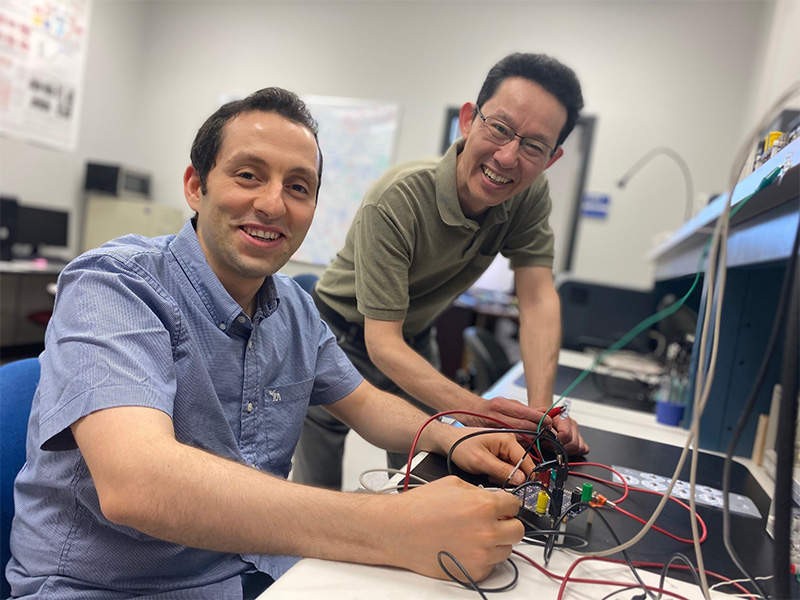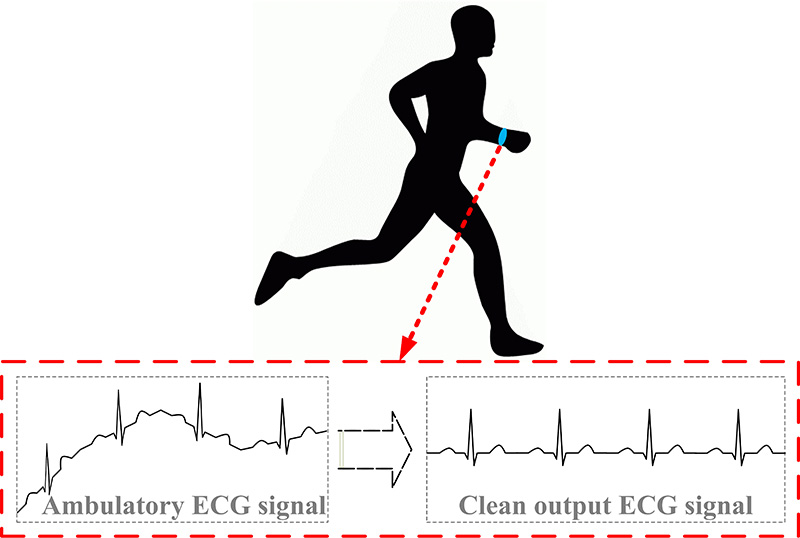University of Akron scientists investigating new technology to aide in the early prevention of heart failure
Researchers at UA are developing a new device that will enable early detection of heart failures, which is the leading cause of death in the U.S. The technology is an ambulatory ECG device that monitors heart activity while patients perform routine activities, such as working, sleeping or exercising.

Doctoral student Masoud Nazari and Dr. Kye-Shin Lee, associate professor of electrical and computer engineering.
The current research underway by Dr. Kye-Shin Lee, associate professor of electrical and computer engineering, and his doctoral student Masoud Nazari can make ambulatory ECG monitoring systems compact, low power and cost efficient. This will contribute to enhancing technical capability and improving clinical practice for ambulatory ECG monitoring that can open new pathways for cardiac disease diagnosis and therapy. The research team recently received a two-year grant from the National Institute of Health for $146,000 for this project, Fully-Analog Motion Artifact Elimination Circuit for Compact and Low Power A-ECG Monitoring Devices.
“Current similar technology is not the best because the quality of ambulatory ECG signals can be critically degraded by motion artifacts originating from various body movements that corrupt the ECG features; even breathing can affect the quality of the ECG signal,” says Lee. “Therefore, motion artifact elimination is the key element of ambulatory ECG monitoring. The ultimate goal of our research is to benefit bio-medical device and sensors by effectively using analog integrated circuit technology.”
The conventional stationary ECG monitoring can reveal harmful cardiac abnormalities; however, it is not feasible for long term non-stationary recording for detecting transient loss of consciousness (T-LOC), lightheadedness or palpitations which occur only once or twice a month or even a few times per year. As a result, for long term and continuous monitoring, there is an increasing demand for ambulatory ECG monitoring that can effectively record ECG signals while the patient is performing routine activities.
Rather than relying on costly software or digital processing-based motion artifact elimination schemes, Lee and Nazari have the goal to eliminate the motion artifacts in the analog domain within the ECG sensor frontend. Their proposed fully analog ECG motion artifact elimination technique can be realized with a smaller number of components, since everything can be integrated in a one-chip package, have lower power consumption and lower cost and can be more effective for multi-channel and remote ECG monitoring applications.

Ambulatory ECG monitoring with ECG waveform corrupted by motion artifact and clean ECG waveform obtained by the team’s device.
“With the new device, patients can have early alert of abnormal heart activity at anytime and anywhere, and the heart condition of the patient can be remotely tracked real-time by the medical doctor,” says Nazari. “The device will not cause much discomfort due to small size and light weight, thus will give more flexibility to the patient in daily life.”
The research has the potential to benefit companies that manufacture ambulatory ECG recording devices, such as Holter monitors, and can potentially improve the functionality of well-known health care devices, such as the Apple Watch, Samsung Galaxy Watch and Fitbit devices.
Future research projects will explore the compact and low-power wireless communication and the ECG data analysis module that will include the fully analog machine learning based data classifier, trained to effectively detect specific features or patterns in the ECG waveform. This can also replace digital processing and software-based approaches for inspecting ECG features, which currently require intensive computing and high-power consumption.
Media contact: Alex Knisely, 330-972-6477 or aknisely@uakron.edu.
